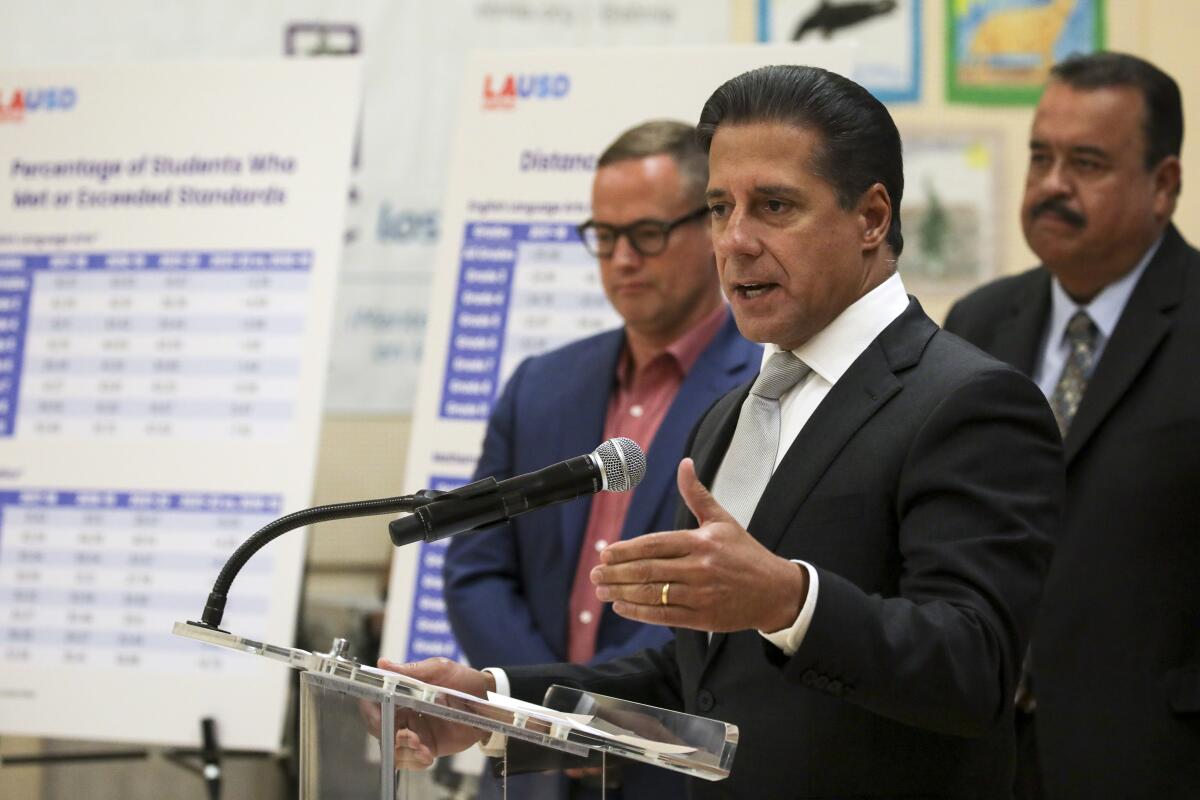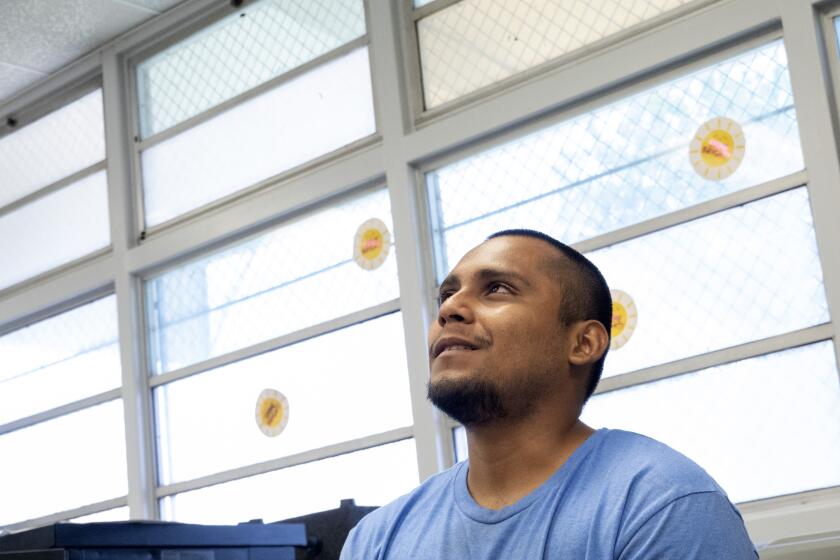L.A. student scores show deep pandemic setbacks, with 72% failing to meet math standards

L.A. Unified test scores released Friday showed the harsh reality of the pandemic’s effects on learning across all grade levels, with about 72% of students not meeting state standards in math and about 58% not meeting standards in English, deep setbacks for a majority of Los Angeles schoolchildren who were already far behind.
The scores show that about five years of gradual academic progress in the nation’s second-largest school district have been reversed, L.A. schools Supt. Alberto Carvalho said Friday.
“The pandemic deeply impacted the performance of our students,” said Carvalho, who spoke at a news conference at Aragon Avenue Elementary School in Cypress Park. “Particularly kids who were at risk, in a fragile condition, prior to the pandemic, as we expected, were the ones who have lost the most ground.”
Carvalho said he wants to make up two years of lost ground this year and make up five years of reverses over the next two years.
The results of the state’s 2022 Smarter Balanced assessments in L.A. Unified reflect a five-point increase in the percentage of students who don’t meet math standards and a two-percentage-point increase for English language arts, when compared with the 2018-19 pre-pandemic academic year.
The declines are significant in a district where, before the pandemic, most students were not meeting state standards in English or math, with scores several percentage points below overall state scores and large achievement gaps between student groups.
The results showed declines across almost all grade levels and many student groups. They are especially concerning for older students and for some of the most vulnerable groups.
About 81% of 11th-graders did not meet grade-level standards in math. About 83% of Black students, 78% of Latino students and 77% of economically disadvantaged students did not meet the math standards.
Girls saw some of the biggest declines in performance — nearly 73% were not meeting math standards in 2022, compared with 67% before the pandemic.
“That is an anomaly, for over the past years, female students have actually been outperforming male students in math and science courses,” Carvalho said. “This is a regression that merits deep, deep analysis and research.”
Although these test results were widely anticipated, they were cause for alarm among experts and advocates.
The types of students who fared the worst “are not small subgroups in California, particularly in L.A.,” said UCLA education professor Tyrone Howard. “This has consequences for us as a state, as a city [and] I think it poses significant challenges about who we are and who we want to be if we’re not intentional about who is being left behind.”
National assessments show that 9-year-olds suffered big drops in reading and math scores, with students who were already struggling seeing the biggest decline.
The district released a summary of overall numbers Friday but did not include detailed breakdowns by student racial, gender and economic groups. These data were described in a Sept. 1 Board of Education report marked “not for public release,” which was obtained by The Times.
Results of the Smarter Balanced assessments, which gauge whether students are meeting state standards, have been limited since the start of the pandemic, making it difficult to assess student progress during distance learning and other pandemic disruptions of the last two school years.
The tests were canceled during the 2019-20 school year, when campuses closed early in the pandemic. The following school year, 2020-21, districts were given flexibility and many, including L.A. Unified, largely chose to administer their own locally chosen assessments, rather than the statewide tests.
For those reasons, the 2021-22 tests offer the first opportunity to broadly compare performance from before the pandemic versus now.
Although the California Department of Education is allowing school systems to release their scores, it has not posted statewide scores on its website, which would allow the public to search scores for individual districts. But experts expect to see drops in performance in districts across the state.
Before the pandemic, a majority of students across Los Angeles were already struggling to meet state standards. In 2018-19, the last school year before the pandemic, 67% of L.A. Unified students did not meet math standards and 56% did not meet English standards, with scores for Black, Latino and low-income students significantly lower.
Carvalho has pledged to increase student performance on the statewide assessments as part of the strategic plan he released earlier this year.

By 2026, the goal is to move third-graders, on average, 30 points closer to meeting standards on the English test, compared with the 2022 scores. Carvalho aims to move third- through eighth-graders, on average, 40 points closer in math. The tests are administered to students in third through eighth and 11th grades and are scored on a range of about 2,000 to 3,000 points.
Achieving the goals would bring students much closer to proficiency in English. According to the board report, third-graders are now, on average, about 33 points away from meeting English standards.
But when it comes to math, many students are much further away from meeting the standards. Eighth-graders, for example, are, on average, about 91 points away from the standards. So even if the goal is met, students will still be far behind.
District strategies to help address the setbacks include using assessment data to help guide instructional planning, deploying “high-impact” intervention programs, and offering multiple opportunities for intervention and credit recovery during and outside of the regular school day.
Ana Ponce, executive director of GPSN, a local education advocacy group, urged L.A. Unified to focus “its energy on where the real hurt has occurred,” with targeted investments for the students most harmed by the pandemic.
She also said that the district should make public more detailed assessment data.
“Los Angeles Unified’s current data release does not allow us to explore if our most vulnerable students were the hardest hit academically,” Ponce said. “This information is long overdue.”
An influx of billions of dollars of state funding is aimed at addressing the crisis, but the need is urgent.
Carvalho also unveiled what he characterizes as part of the district’s learning recovering strategy: a counter proposal for bargaining with United Teachers Los Angeles. The package includes, both for this year and next year, a 4% raise and a 3% bonus. It also targets areas of high need for special attention. Nurses, for example, would be offered a $20,000 salary increase to make district compensation more competitive with the private market.
The union wants an across-the-board wage increase of 10% for each of the next two years in a package of demands that, like the district’s, is detailed.
The district’s test scores are yet another data point in an increasingly clear picture of the negative effects of the pandemic and school closures on student academic performance.
Earlier this month, the results of national reading and math tests given to 9-year-olds showed the steepest declines in decades, with the biggest drops among children who were already struggling.
Experts warned, however, that the troubling test scores emerging across the nation are not solely the result of the pandemic. They are the outcome of stresses on educational systems that have long been inadequate, particularly in math and for the most vulnerable student groups.
And, they said, the way to fix the problems isn’t by doing more of the same.
“This requires a collective anger over why we allowed these gaps to persist in the first place,” UCLA’s Howard said. “We know the ZIP Codes, we know the neighborhoods, we know the students that suffer from a cumulative disadvantage.”
Howard said schools must develop efforts that focus intently on the students who are most behind.
“This is an opportunity for a strategic approach to say, ‘How do we target specific groups?’ We know who they are,” he said, including Black students, Latino students, English learners and students with disabilities.
Rick Miller, chief executive of the CORE Districts, a consortium of large California school districts, said there is now a “generational challenge” in front of educators.
In math, in particular, it was clear before the pandemic that many students were not learning foundational skills needed to progress to higher-level work, Miller said.
For example, students often learn how to get the right answer when multiplying fractions such as one-half times two-thirds.
But “they don’t understand why one-half times two-thirds equals that answer,” Miller said. “Kids will just learn to respond. They will mimic what you showed them in class. They’re not really learning it.”
“We have to sort of go back in the system and think differently about how we’re teaching these foundational skills,” he said.
More to Read
Sign up for Essential California
The most important California stories and recommendations in your inbox every morning.
You may occasionally receive promotional content from the Los Angeles Times.














